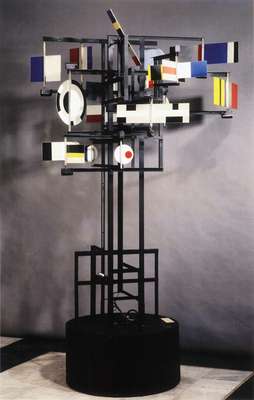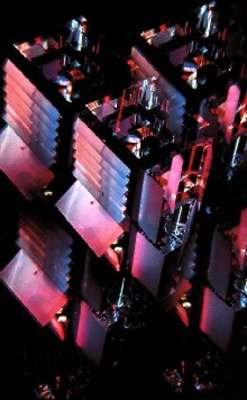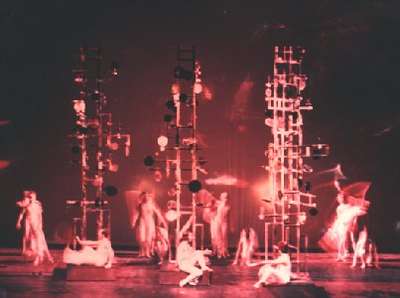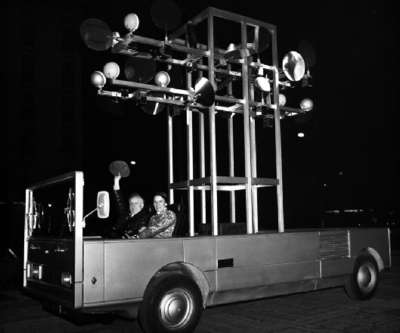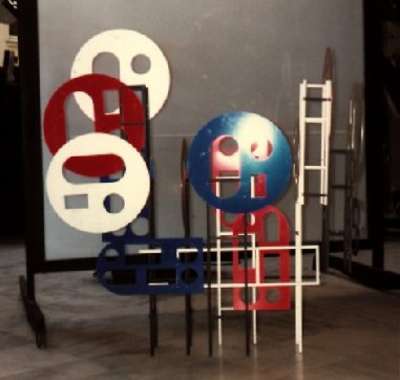| Early Life |
Studies drawing, painting and piano starting at the age of 7. Secondary studies in the Jesuit College of Kalocsa. Graduates from the School of Fine Arts in Budapest (Hungary). |
| 1932 |
Participates in the exhibition at Nemzeti Szalon (exhibition hall of the Society of Hungarian Artists and Patrons), Budapest. |
| 1936 |
Studies at the Ecole Nationale Supérieure des Beaux-Arts de Paris (Atelier Sabatté). Lives in Paris since this date. |
| 1938 |
Participation in the ‘Living room of the Independent ones’. |
| 1939 to 1945 |
Takes refuge in Auvergne, in the area of Capdenac during World War II. |
| 1941 |
Employed in a foundry in the factories of Chélassière in Saint-Etienne, France. |
| 1947 |
Exhibition at the Gallery Breteau (Paris), naturalized as a French citizen on June 25. |
| 1948 |
Participates in the exhibition ‘The Compass card’, Gallery of the Two-Islands, Paris. Develops ideas on ‘Spatiodynamisme’. |
| 1949 |
Participates in the exhibition ‘Eloquence of the Line’, Gallery of the Two-Islands, Paris. |
| 1950 |
Exhibits for the first time Spatiodynamic Sculptures – ‘Spatiodynamique 1’ and prototype of ‘Spatiodynamique 2’ at the Galerie des Deux-Iles, Paris. Participates in the ‘Mobiles of the Love’, Harriet Hubbard Ayer, in Paris and Marseilles. Creates a ‘Spatiodynamic Electric Clock’, realized with Henri Perlstein, engineer, and financed by André Bloc. |
| 1951 |
Participates in the ‘Salon de la Jeun Sculpture’ with the Spatiodynamique 11 at the court of the Museum of Modern Art. |
| 1953 |
Participates in the group show ‘Quatre et quatre’, Gallery Colette Alendy, Paris. |
| 1954 |
Creates the ‘Cybernetic and Sound Spatiodynamique’ (50 m high) for the 1st Salon Bâtimat, Paris (France). Releases his first book Spatiodynamisme (ED. AA, Boulogne) |
| 1955 |
Constructs a house with invisible dividing wall, for the 2nd Salon Bâtimat, Paris (France). |
| 1956 |
Creates the First Autonomous Cybernetic Sculpture, ‘CYSP 1’, presented by André Parinaud, at The Night of Poetry, Sarah Bernhardt Theatre in Paris. |
| 1958 |
Exhbition at the Galerie Denise René, Paris. |
| 1959 |
Participates at Documenta 2, Kassel, Germany. |
| 1960 |
Exhibition at the Institute of Contemporary Arts, London. |
| 1961 |
Realises the Cybernetic Tower of Liège (52 m high – 66 revolving mirrors – 120 colored projectors – photoelectric cells and microphones), together with a 1500 sq-m animated coloured performance on the façade of the Palace of Congress, reflected by the Meuse river, with music by Henri Pousseur. |
| 1961 |
1st Video production in the history of television: ‘Variations Luminodynamiques 1’ (Télévision Française). |
| 1963 |
Retrospective exhibition at the Musée des Arts Décoratifs, Pavillon de Marsan, Le Louvre (Paris) where the reduced model of the Cybernetic Light Tower of Paris-La Défense is shown for the first time. |
| 1964 |
Participates at Documenta 3, Kassel, Germany. |
| 1965 |
Co-founder of GIAP (International Group of Prospective Architecture)^. Exhibition at “2 Kinetic Sculptors: Nicolas Schöffer and Jean Tinguely” in Jewish Museum (New York) and Washington Gallery of Modern Art, Washington D.C. |
| 1966 |
Participates in the ‘Lumière et mouvement’, Museum of Modern Art, Paris. |
| 1968 |
Receives the first Grand Prize of the Biennale of Venice. Creates the PRISM for the exhibition of the Y.E.A.A. (Tokyo). |
| 1969 |
Co-creation of the UP7 (Pedagogical Unit of Prospective Architecture) in the Fine-Arts School of Paris |
| 1970 |
Exhibits the 12 m animated maquette of the T.L.C. (Cybernetic Light Tower of Paris-La Défense) at the Universal Exposition, Osaka (Japan). |
| 1971 |
Participates in ‘Art et Science’, Museum of Tel Aviv, Tel Aviv, Israel. |
| 1973 |
Exhibits SCAM 1, 1st Auto-Mobile-Sculpture in Milan (Italy) and Paris (chassis: Renault; coachwork: Coggiola, Torino) |
| 1973 |
KYLDEX 1. 1st experimental cybernetic show, at Hamburg Opera House, with music by Pièrre Henry, choreography by Alwin Nikolais with Carolyn Carlson. |
| 1974 |
Exhibits in the Musée d’Art Moderne de la Ville de Paris, Installation of a 20 m programmed sculpture: CHRONOS 8, San Francisco (USA). |
| 1975 |
Exhibits at the Galerie Denise René / Hans Meyer, Düsseldorf (Germany). |
| 1977 |
Creates the first luminodynamic tapestry: MURLUX 1, woven out of plastic tubes. Starts research in sound. Exhibits at the Museum of Modern Art, Bonn (Germany). |
| 1980 |
Inauguration of the Nicolas Schöffer Museum in his birth place, Kalocsa (Hungary) |
| 1981 |
Initiates experiments with GRAPHILUX, an instrument to promote literacy and artistic pedagogy at kindergartens and primary schools, in Kalocsa. Conducts musical experiments ‘Variations on 600’ within the framework of the IRCAM Computer Sound-Structure Research program, Paris. |
| 1982 |
A 26 m cybernetic tower, CHRONOS 8, is inaugurated at Kalocsa (Hungary). Elected as a Member of the Institute of France, Fine Arts Academy. |
| 1984 |
Organises the first Seminar in Kalocsa : ‘New Technologies in Contemporary Artistic Research’. |
| 1985 |
Organises the second Seminar in Kalocsa : ‘New Research in Contemporary Music’. International workshop organised by UNESCO for the promotion of the GRAPHILUX, Nice (France). As the result of a stroke he cannot use his right hand and arm anymore. |
| 1986 |
Organises the third Seminar in Kalocsa : ‘New Reseach in Graphic Poetry’. |
| 1988 |
Installation of the 27 m high TOUR D’AIN, at the A40 and A42 highway crossroads, Pont d’Ain (France). Installation of the 30 m LYONEON, a cybernetically programmed neon tower for the new metro station, place d’Arsonval, Lyon (France). Starts research with his left hand on the Macintosh computer ORDIGRAPHICS. Participates in the exhibition ‘Digital Visions’, Gallery IBM, New York. |
| 1989 |
Participates in the first French Academy of Beaux-Arts exhibition in Moscow, Russia. Exhibits the projects ‘Percussonors, Basculantes and Hydrothermochronos’ at the Hungarian Institute, Paris. |
| 1990 |
The President of the Republic decorates him Commander of the National Order of Merit in the Elysée Palace, Paris (France). |
| 1991 |
Organises the fourth Seminar in Kalocsa: ‘New Research in Architecture’ at the Schöffer Mùzeum, Kalocsa (Hungary). |
| 1992 |
Dies on the 6th of January. |



